Comments / Questions (36)
![]() Christine wrote:
Christine wrote:
Bei den Ärmeln sollen in der letzten Reihe von A13 bis A15 am Anfang und am Ende Luftmaschen gehäkelt werden. Soll die Reihe dann gleich im Anschluß geschlossen werden oder erst nach der ersten Reihe von A7 bis A9 ? Im Text ist das etwas unklar formuliert. Viele Grüße !
08.02.2025 - 19:11DROPS Design answered:
Liebe Christine, die Arbeit wird in Runden weiter gehäkelt ab 1. Runde A.7-A.9. Viel Spaß beim Häkeln!
10.02.2025 - 10:08
![]() Christine wrote:
Christine wrote:
Das stimmt, es würde sonst nicht aufgehen, weil A.14 ja fortlaufend wiederholt wird. Auf alle Fälle ist ein Stäbchen (in A.13) aber zuviel aufgezeichnet. Viele Grüße !
07.12.2024 - 17:08
![]() Christine wrote:
Christine wrote:
Ist in der letzten Reihe von A.14 nicht ein Stäbchen zuviel im Diagramm aufgezeichnet ? Viele Grüße !
06.12.2024 - 11:52DROPS Design answered:
Liebe Christine, ich würde lieber nur 1 Stäbchen am Anfang A.13 (bei der letzten Reihe = um das letzte Luftmaschenbogen, nicht an der Seite) häkeln; so sind es immer 3 Stäbchen um jedes Luftmaschenbogen + eventuel. die Zunahmen. Viel Spaß beim Häkeln!
06.12.2024 - 15:38
![]() Christine wrote:
Christine wrote:
Wenn man bei den Ärmeln 1x A.13 bis A.15 gehäkelt hat, soll es mit A.12 (?), A.14 und A.15 weitergehen. Ist das vielleicht ein Druckfehler ? Viele Grüße und einen schönen Advent !
01.12.2024 - 12:28DROPS Design answered:
Liebe Christine, ja das meine ich auch, es sollte sicher A.13 sein damit die Ärmel symmetrisch wird. Danke für den Hinweis, Viel Spaß beim Häkeln!
02.12.2024 - 09:35
![]() Christine wrote:
Christine wrote:
Danke für ihre Bemühung ! Ich habe noch eine Unstimmigkeit entdeckt : A.10 und A.12 sind in der dritten Reihe nicht symmetrisch . Viele Grüße !
29.11.2024 - 11:34
![]() Christine wrote:
Christine wrote:
Bei den Ärmeln der Jacke soll man am Anfang 2 Stäbchen in die 4. Luftmasche häkeln. Das würde dann insgesamt 3 Stäbchen ergeben, weil die ersten drei Luftmaschen als Ersatzstäbchen ja mitzählen ( siehe Anleitung ). Dann hat man am Ende der Reihe aber ein Stäbchen mehr als die angegebene Anzahl. Können Sie das bitte überprüfen ? Viele Grüße !
26.11.2024 - 12:01DROPS Design answered:
Liebe Christine, dann häkeln Sie vielleicht am besten 1 Stäbchen weniger, oder zählen die ersten 3 Luftmaschen nicht als 1. Stäbchen - den Hinweis habe ich unser Design Team weitergeleitet. Viel Spaß beim Häkeln!
26.11.2024 - 16:30
![]() Christine wrote:
Christine wrote:
Ja, das stimmt, die Maschenanzahl ist die gleiche. Aber die Stäbchen könnten dennoch identisch (bzw. im Vergleich zur entsprechenden Reihe gespiegelt) verteilt sein. Das hat ja dann auch Auswirkungen auf die Verteilung der Maschen in der nächsten Reihe. Ich habe beide Reihen so wie in A.4c-A.6c gehäkelt (A.1c-A.3c gespiegelt) und das hat gut gepaßt, auch für die nächste Reihe. Viele Grüße !
05.11.2024 - 11:50
![]() Christine wrote:
Christine wrote:
Danke für die Antwort, aber ich meinte die ÄUSSERSTEN Ränder der letzten Reihe. In A.3c sind z.B. im äußersten Luftmaschenbogen zwei, in A.4c jedoch drei Stäbchen abgebildet. Beim Übergang von A.1c zu A.2c sind es zwei, beim entsprechenden Übergang von A.5c zu A.6c nur ein Stäbchen...Viele Grüße !
04.11.2024 - 19:59DROPS Design answered:
Liebe Christine, in beiden Fällen sind es aber 12 Stäbchen, so stimmt die gesamte Maschenanzahl der Reihe in A.3c sowie in A.4c, oder misverstehe ich immer noch etwas?
05.11.2024 - 09:34
![]() Christine wrote:
Christine wrote:
Mir ist noch etwas aufgefallen : Im Diagramm ist A.1-A.3 symmetrisch mit A.4-A.6. In der letzten Reihe sind die Stäbchen an den Rändern jedoch unterschiedlich verteilt. Können Sie das bitte überprüfen ? Viele Grüße !
04.11.2024 - 11:31DROPS Design answered:
Liebe Christine, es solle aber immer 3 Stäbchen um jeden Luftmaschenbogen gehäkelt werden: am Ende A.2: 1 Stäbchen um den Luftmaschenbogen + 2 Stäbchen im gleichen Luftmaschenbogen am Anfang A.3c; in A.4c: 1 Stäbchen um den Luftmaschenbogen + 2 Stäbchen um den gleichen Luftmaschenbogen am Anfang A.5c. Viel Spaß beim Häkeln!
04.11.2024 - 14:38
![]() Christine wrote:
Christine wrote:
Danke für ihr Engagement ! Bisher habe ich es (auch deswegen) immer bis zum Ziel geschafft. Habe schon ca. 10 Jacken mit ihrer Wolle und den dazugehörigen Anleitungen gehäkelt und es macht immer noch Spaß ! Viele Grüße !
29.10.2024 - 15:29
Daniella#daniellacardigan |
|||||||||||||||||||||||||||||||
 |
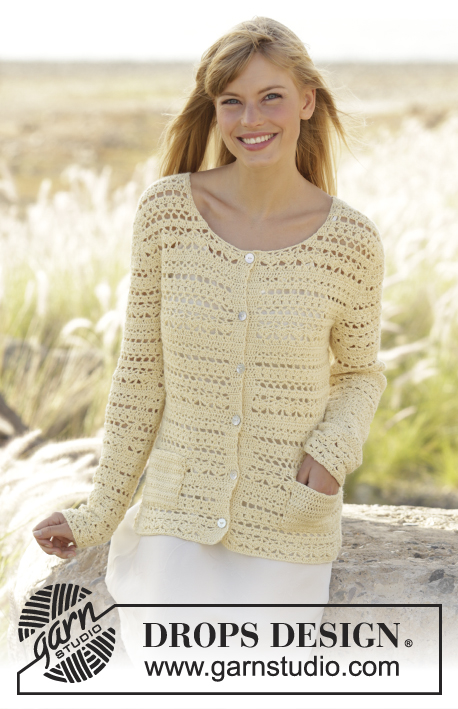 |
||||||||||||||||||||||||||||||
Crochet DROPS jacket with pockets and skirt with lace and fan pattern, worked top down in ”Alpaca”. Size: S - XXXL.
DROPS 170-31 |
|||||||||||||||||||||||||||||||
|
PATTERN: See diagrams A.1 to A.15. CROCHET INFO: On every dc row replace first dc with 3 ch. On every sc row replace first sc with 1 ch. DECREASE TIP: Work until 5 dc remain before markers in the side, work the next 2 dc tog, work 1 dc in each of the next 2 dc, work the next 2 dc tog, work 1 dc in each of the next 2 dc, work the next 2 tog (= 3 dc dec at each marker = 6 dc dec in total). INCREASE TIP: Work until 4 dc remain before markers in the side, work 2 dc in next dc, work 1 dc in each of the next 2 dc, work 2 dc in next dc, work 1 dc in each of the next 2 dc, work 2 dc in next dc (= 3 dc in at each marker = 6 dc inc in total). ---------------------------------------------------------- JACKET: Worked top down, back and forth. BACK PIECE: RIGHT SHOULDER: Work 27-31-35-35-39-42 ch on hook size 3.5 mm/E/4 with Alpaca. Work next row as follows: Work 1 dc in 4th ch from hook (= 2 dc) - READ CROCHET INFO, 1 dc in each of the next 3-2-1-1-0-3 ch, * skip ch 1, 1 dc in each of the next 4 ch *, repeat from *-* = 21-24-27-27-30-33 dc. Then work next row from RS as follows: Work A.4a over the first 4 dc, repeat A.5a over the next 15-18-21-21-24-27 dc (= 5-6-7-7-8-9 times in total in width), A.6a over the last 2 dc. When A.4a and A.6a have been worked 1 time vertically (= last row is from WS). Put piece aside and work left shoulder. REMEMBER THE CROCHET GAUGE! LEFT SHOULDER: Work 27-31-35-35-39-42 ch on hook size 3.5 mm/E/4 with Alpaca. Work next row as follows: Work 1 dc in 4th ch from hook (= 2 dc), 1 dc in each of the next 3-2-1-1-0-3 ch, * skip ch 1, 1 dc in each of the next 4 ch *, repeat from *-* = 21-24-27-27-30-33 dc. Then work next row from RS as follows: Work A.1a over the first 2 dc, repeat A.2a over the next 15-18-21-21-24-27 dc (= 5-6-7-7-8-9 times in total in width), A.3a over the last 4 dc. When A.1a to A.3a have been worked 1 time vertically, work left shoulder tog with right shoulder from RS as follows: BACK PIECE: SIZE S-M: Work A.1b over the first 2 dc on left shoulder, repeat A.2b over the next 18-21 dc, 1 dc in last dc on left shoulder, work 39-39 ch for neck, work 1 dc in each of the first 2 dc on right shoulder, repeat A.2b over the next 18-21 dc and 1 dc in last dc over right shoulder as before = 42-48 dc and 39-39 ch on row. On next row work pattern as before but work 1 dc in every ch = 81-87 dc. SIZE L-XL-XXL-XXXL: Work A.1a over the first 2 dc on left shoulder, repeat A.2a over the next 24-24-27-30 dc, 1 dc in last dc on left shoulder, work 39-45-45-45 ch for neck, work 1 dc in first dc on right shoulder, repeat A.5a over the next 24-24-27-30 dc and A.6a over the last 2 dc on right shoulder as before = 54-54-60-66 dc and 39-45-45-45 ch on row. On next row work pattern as before but work 1 dc in every ch = 93-99-105-111 dc. When A.1a and A.6a have been worked 1 time vertically, work as follows from RS: Work 1 dc in each of the first 2 dc, repeat A.2b until 1 dc remains, finish with 1 dc in last dc. Repeat A.2b 1-1-2-2 times in total. ALL SIZES: = 81-87-93-99-105-111 dc. Work as follows from RS: A.7b over the first 2 dc, repeat A.8b over the next 72-78-84-90-96-102 dc (= 12-13-14-15-16-17 times in total in width), finish with A.9b over the last 7 dc. When A.7b to A.9b have been worked 1 time vertically, repeat A.7 over A.7b, A.8 over A.8b and A.9 over A.9b vertically. SIZE L-XL-XXL-XXXL: When piece measures 17-18-16-16 cm / 6 3/4"-7"-6 1/4"-6 1/4", inc 1 dc in each side of piece by working 2 dc in first and last dc (= 2 dc inc). Repeat inc on every row 1-1-5-6 more times (= 4-4-12-14 dc inc in total). Work the inc dc into pattern. Work sts that do not fit pattern as A.7. After inc piece measures approx. 19-20-21-22 cm / 7½"-8"-8 1/4"-8 3/4". ALL SIZES: When piece measures 17-18-19-20-21-22 cm / 6¾''-7''-7½''-8''-8¼''-8¾'' – adjust so that next row is from RS and is a row with dc (in diagram A.8), fasten off. Put piece aside and work front piece. RIGHT FRONT PIECE: Work 27-31-35-35-39-42 ch on hook size 3.5 mm/E/4 with Alpaca. Work next row as follows: Work 1 dc in 4th ch from hook (= 2 dc), 1 dc in each of the next 3-2-1-1-0-3 ch, * skip ch 1, 1 dc in each of the next 4 ch *, repeat from *-* = 21-24-27-27-30-33 dc. Then work next row from RS as follows: Work A.1a over the first 2 dc, repeat A.2a over the next 15-18-21-21-24-27 dc (= 5-6-7-7-8-9 times in total in width), A.3a over the last 4 dc. Repeat A.1a to A.3a vertically 1-1-2-2-2-2 times in total. Then work A.1b over A.1a, A.2b over A.2a and A.3b over A.3a. Repeat A.1b to A.3b vertically 1-1-1-1-2-2 times in total. Work A.1c over A.1b, A.2c over A.2b and A.3c over A.3b. Cut and fasten the yarn when 1 row remains in diagram. Work 14-17-14-20-17-20 loose ch in hook size 3.5 mm/E/4 with Alpaca, work last row of diagram A.3c to A.1c from WS = 29-32-35-35-38-41 dc and 14-17-14-20-17-20 ch. On next row work as follows from RS: Work A.7 over the first 2 dc, repeat A.8 over the next 30-36-36-42-42-48 dc/ch (= 5-6-6-7-7-8 times in total in width), A.9 over the next ch 7, finish with 1 dc in each of the last 4 ch (= band). NOTE: Work band as A.7, i.e. on rows with sc work band in sc and on rows with dc work band in dc. SIZE L-XL-XXL-XXXL: When piece measures 17-18-16-16 cm / 6 3/4"-7"-6 1/4"-6 1/4", inc 1 dc in the side of piece by working 2 dc in first dc from RS and last dc from WS (= 1 dc inc per row). Repeat inc on every row 1-1-5-6 more times (= 2-2-6-7 dc inc in total). Work the inc dc into pattern. Work sts that do not fit pattern as A.7. After inc piece measures approx. 19-20-21-22 cm / 7½"-8"-8 1/4"-8 3/4". ALL SIZES: Continue pattern like this. When piece measures 17-18-19-20-21-22 cm / 6¾''-7''-7½''-8''-8¼''-8¾'', adjust pattern according to back piece, fasten off. Put piece aside and work left front piece. LEFT FRONT PIECE: Work 27-31-35-35-39-42 ch on hook size 3.5 mm/E/4 with Alpaca. Work next row as follows: Work 1 dc in 4th ch from hook (= 2 dc), 1 dc in each of the next 3-2-1-1-0-3 ch, * skip ch 1, 1 dc in each of the next 4 ch *, repeat from *-* the entire row = 21-24-27-27-30-33 dc. Then work next row from RS as follows: Work A.4a over the first 4 dc, repeat A.5a over the next 15-18-21-21-24-27 dc (= 5-6-7-7-8-9 times in total in width), A.6a over the last 2 dc. Repeat A.4a to A.6a vertically 1-1-2-2-2-2 times in total. Then work A.4b over A.4a, A.5b over A.5a and A.6b over A.6a. Repeat A.4b to A.6b vertically 1-1-1-1-2-2 times in total. Work A.4c over A.4b, A.5c over A.5b and A.6c over A.6b. On last row in diagram A.4c to A.6c work 17-20-17-23-20-23 ch (includes 3 ch to turn with) at the end of row from WS = 29-32-35-35-38-41 dc and 17-20-17-23-20-23 ch. On next row work as follows from RS: Work 1 dc in 4th ch from hook, 1 dc in each of the next 3 ch (= band), A.7 over the next ch 2, repeat A.8 over the next 30-36-36-42-42-48 ch/dc (= 5-6-6-7-7-8 times in total in width), finish with A.9 over the last 7 dc. Continue pattern like this. NOTE: Work band as A.7, i.e. on rows with sc work band in sc and on rows with dc work band in dc. SIZE L-XL-XXL-XXXL: When piece measures 17-18-16-16 cm / 6 3/4"-7"-6 1/4"-6 1/4" (adjust according to back piece), inc 1 dc in the side of piece by working 2 dc in first dc from WS and last dc from RS (= 1 dc inc per row). Repeat inc on every row 1-1-5-6 more times (= 2-2-6-7 dc inc in total). Work the inc dc into pattern. Work sts that do not fit pattern as A.7. After inc piece measures approx. 19-20-21-22 cm / 7½"-8"-8 1/4"-8 3/4". ALL SIZES: When piece measures 17-18-19-20-21-22 cm / 6¾''-7''-7½''-8''-8¼''-8¾'', adjust pattern according to back piece, fasten off. BODY: Now work the parts tog as follows from RS: Work from left front piece, over back piece and then over right front piece. Work 1 dc in each of the first 4 dc (= left band), work A.7-A.9 over left front piece as before, work 9-9-11-11-15-16 loose ch for armhole (insert a marker thread in the middle of these new sts = under sleeve), work A.7-A.9 over back piece as before, work 9-9-11-11-15-16 loose ch for armhole (insert a marker thread in the middle of these new sts = under sleeve), work A.7-A.9 over right front piece as before, work 1 dc in each of the last dc (= right band) = 167-185-199-217-239-261 dc and 9-9-11-11-15-16 ch in each side of piece (= 185-203-221-239-269-293 sts in total). Insert 1 marker in piece, NOW MEASURE PIECE FROM HERE. Leave marker in piece, move marker threads when working. Work next row as follows from WS: Work 1 dc/sc in each of the first 4 dc/sc (= right band), A.9 over the next 7 dc, repeat A.8 over the next 168-186-204-222-252-276 dc/ch (= 28-31-34-37-42-46 times in total in width), A.7 over the next ch 2, 1 dc/sc in each of the 4 dc/sc (= left band). NOTE: Work bands as A.7 until finished measurements, i.e. on rows with sc work band in sc and on rows with dc work band in dc. Continue pattern like this. When piece measures 4 cm / 1½'', adjust so that next row is with dc, dec 3 dc at each marker thread in the side – READ DECREASE TIP, repeat dec every 6 cm / 2 3/8'' 2 more times = 167-185-203-221-251-275 dc on row. NOTE: Every time you dec, repeat A.8 1 time less in width. When piece measures 18 cm / 7'' from marker, adjust so that next row is a row with dc, inc 3 dc at each marker thread – READ INCREASE TIP, repeat inc every 3 cm / 1'' 3 more times = 191-209-227-245-275-299 dc. NOTE: Every time you inc, repeat A.8 1 more time in width. When piece measures 33-34-35-36-37-38 cm / 13''-13 3/8''-13¾''-14¼''-14½''-15'' from marker, adjust so that last row is a row with dc from WS, work as follows on next row from RS: Work band as before over the first 4 band sts, A.7a over the next 2 dc, repeat A.8a over the next 174-192-210-228-258-282 dc (= 29-32-35-38-43-47 times in total in width), A.9a over the next 7 dc, work over the 4 band sts as before. Fasten off when A.7a to A.9a have been worked 1 time vertically. Piece measures approx. 54-56-58-60-62-64 cm / 21¼''-22''-22¾''-23 5/8''-24 3/8''-25¼'' in total. SLEEVE: The piece is worked top down. Work 21-28-31-38-42-45 ch on hook size 3.5 mm/E/4 with Alpaca. Work 2 dc in 4th ch from hook, 1 dc in each of the next 1-1-2-2-1-2 dc, * skip ch 1, 1 dc in each of the next 6 ch *, repeat from *-* 1-2-2-3-4-4 more times, 1 dc in each of the next 1-1-3-3-1-3 dc, 2 dc in last dc = 18-24-27-33-36-39 dc. Then work as follows from RS: Work A.10 over the first 3 dc, repeat A.11 over the next 12-18-21-27-30-33 dc (= 4-6-7-9-10-11 times in total in width), finish with A.12 over the last 3 dc. When A.10 to A.12 have been worked 1 time vertically, there are 30-36-39-45-48-51 dc on last row. Work next row as follows from RS: Work A.10 over the first 3 dc, repeat A.11 over the next 24-30-33-39-42-45 dc (= 8-10-11-13-14-15 times in total in width), finish with A.11 over the last 3 dc. When A.10 to A.12 have been worked 1 more time vertically, there are 42-48-51-57-60-63 dc on last row. Work next row as follows from RS: Work A.13 over the first 3 dc, repeat A.14 over the next 36-42-45-51-54-57 dc (= 12-14-15-17-18-19 times in total in width), finish with A.15 over the last 3 dc. When A.13 to A.15 have been worked 1 time vertically, there are 54-60-63-69-72-75 dc on last row. Work next row as follows from RS: Work A.12 over the first 3 dc, repeat A.14 over the next 48-54-57-63-66-69 dc (= 16-18-19-21-22-23 times in total in width), finish with A.15 over the last 3 dc. When last row of A.13 to A.15 remain, cut the yarn. Work 5-5-6-6-8-8 loose ch. Work from RS last row of A.15, repeat last row of A.14 16-18-19-21-22-23 times in total in width AT THE SAME TIME inc 0-0-1-1-0-2 dc evenly, work last row of A.13, finish by working 4-4-5-5-7-8 ch at the end of row = 66-72-76-82-84-89 dc and 9-9-11-11-15-16 ch (= 75-81-87-93-99-105 sts in total). Work next row as follows from RS: Work A.7 over the first ch 2, repeat A.8 over the next 66-72-78-84-90-96 ch/dc (= 11-12-13-14-15-16 times in total in width), finish with A.9 over the last 7 dc/ch. Insert 1 marker in the piece. NOW MEASURE PIECE FROM HERE. Insert 1 marker thread mid under sleeve. Then work piece back and forth but work every row tog at the end of row with 1 sl st in 3rd ch on row. Turn piece. When piece measures 4 cm / 1½'', adjust so that next row is with dc, dec 6 dc evenly. Repeat dec every 9-7-5-5-4½-4 cm / 3½"-2 3/4"-2"-2"-1 3/4"-1 3/4" 3-4-5-5-6-7 more times = 51-51-51-57-57-57 dc. NOTE: Every time you dec, repeat A.8 1 time less in width. When piece measures 34 cm / 13½", adjust so that next row is with dc, dec 3 dc evenly = 48-48-48-54-54-54 dc. Then repeat A.8a 8-8-8-9-9-9 times in total in width. Work A.8a 3 times in total vertically. Fasten off when piece measures 56 cm / 22'' in total, finish neatly according to pattern. Work another sleeve the same way. POCKETS: Cast on 30 ch on hook size 3.5 mm/E/4 with Alpaca. Work 1 dc in 4th ch from hook (= 2 dc), 1 dc in each of the next 2 dc, * skip ch 1, 1 dc in each of the next 5 ch *, repeat from *-* = 24 dc. Work 1 dc in every dc until piece measures approx. 9 cm / 3½''. Work 1 row with * 1 sc, ch 3, skip 1 cm / 3/8'' *, repeat from *-*, adjust to finish with 1 sc in last dc. Fasten off. Work another pocket the same way. ASSEMBLY: Sew the shoulder seams. Sew in sleeves in outer loops of edge sts. Sew pockets in the middle of front piece approx. 8 cm / 3 1/8'' up from edge. Fasten buttons on left front piece, fasten the top button approx. 2 cm / 3/4'' from neck edge, then fasten them approx. 9-9-8-8-8-8 cm / 3½"-3½"-3"-3"-3"-3" apart. Button between 2nd and 3rd dc on band. NECK EDGE: Work an edge around the neck as follows (beg mid front): Work 1 sc in first dc, * ch 3, skip approx. 1 cm / 3/8'' *, repeat from *-* around the entire neck, make sure to avoid a tight edge, adjust to finish with 1 sc in last dc. Fasten off. ---------------------------------------------------------- SKIRT: PATTERN: See diagrams A.16 and A.17. Diagram A.17 shows how every round beg and ends when working A.16 in the round. CROCHET INFO: Replace first dc at beg of every dc row with 3 ch. Replace first sc at beg of every sc row with 1 ch. Beg every round with dc with 3 ch (= first dc) and finish with 1 sl st in 3rd ch. Beg every round with sc with 1 ch (replace first sc) and finish with 1 sl st in first ch. INCREASE TIP-1: Inc 1 dc by working 2 dc in/around same st. INCREASE TIP-2 (evenly spaced): To calculate how often inc should be done on row, use the total no of sts (e.g. 228 dc) and divide the remaining sts by no of inc to be done (e.g. 12) = 18.33. I.e. in this example work 2 dc in approx. 18th dc. ---------------------------------------------------------- SKIRT: Work back and forth, top down to after vent in the side, then work in the round. Work 176-190-204-232-267-302 ch (includes 3 ch to turn with) on hook size 3.5 mm/E/4 with Alpaca. Work first row as follows: 1 dc in 4th ch from hook (= 2 dc), 1 dc in each of the next ch 4, * skip ch 1, 1 dc in each of the next 6 ch *, repeat from *-* = 150-162-174-198-228-258 dc. Then work back and forth with 1 dc in every dc - READ CROCHET INFO. REMEMBER THE CROCHET GAUGE! When 6-6-4-4-6-6 rows have been worked vertically, insert 6 markers in the piece as follows: First marker after 13-14-15-17-19-21 dc, then there should be 25-27-29-33-38-43 dc between every marker, there will be 12-13-14-16-19-22 dc after last marker at the end of row. Let markers follow in piece. On next row inc 1 dc before all markers (= 6 dc inc) – READ INCREASE TIP-1! Repeat inc every other row/round 12-12-14-14-14-14 more times. - NOTE: Inc alternately before and after markers = 228-240-264-288-318-348 dc. AT THE SAME TIME when 12 rows in total have been worked vertically, end the vent in the side and continue piece in the round, beg round in the side. When piece measures 28-29-30-31-32-33 cm / 11''-11 3/8''-11¾''-12¼''-12½''-13'', work A.16 (= 6 dc) 38-40-44-48-53-58 times in total on round. On 5th, 10th and 14th round in A.16 (= dc round) inc 12 dc evenly on each round – READ INCREASE TIP-2 = 264-276-300-324-354-384 dc. For every inc, work A.16 2 times more in width. When A.16 has been worked 1 time vertically, piece measures approx. 39-40-41-42-43-44 cm / 15¼''-15¾''-16 1/8''-16½''-17''-17¼''. Repeat A.16 and inc 1 more time = 300-312-336-360-390-420 dc. When piece measures 50-52-54-56-58-60 cm / 19 3/4''-20½''-21¼''-22''-22¾''-23 5/8'' in total, adjust so that last round is a round with dc, work A.16a 50-52-56-60-65-70 times in total in width. Fasten off when A.16a has been worked 1 time vertically. Piece measures approx. 52-54-56-58-60-62 cm / 20½''-21¼''-22''-22¾''-23 5/8''-24 3/8''. BUTTONHOLE LOOPS: Along one side of the opening on front piece work buttonhole loops as follows (beg at the bottom): 2 sc in first dc, ch 3, skip 1 dc, * work 2 sc in each of the next 2 dc, ch 3, skip 1 dc *, repeat from *-* 3 times in total and finish with 2 sc in last dc at the top, turn and work back as follows: 1 sc in every sc and 3 sc in every ch-space. BUTTON BAND: Along the other side of the opening work 5 rows with sc back and forth (on first row work 2 sc in every dc = 24 sc), cut the yarn. Sew the buttons on to the button band. |
|||||||||||||||||||||||||||||||
Diagram explanations |
|||||||||||||||||||||||||||||||
|
|||||||||||||||||||||||||||||||

|
|||||||||||||||||||||||||||||||
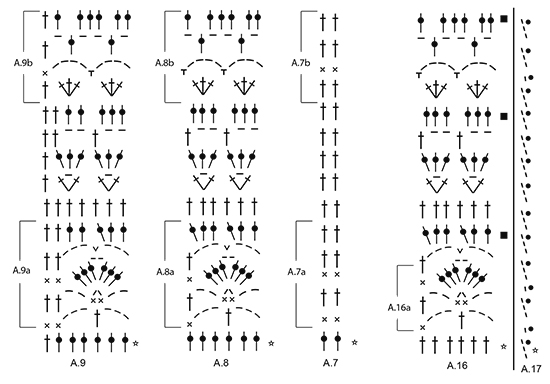
|
|||||||||||||||||||||||||||||||
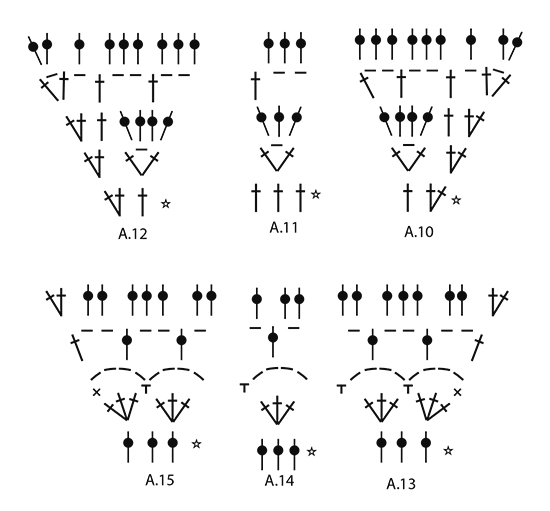
|
|||||||||||||||||||||||||||||||
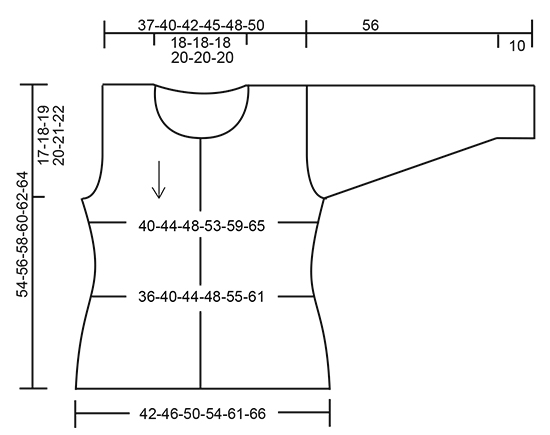
|
|||||||||||||||||||||||||||||||
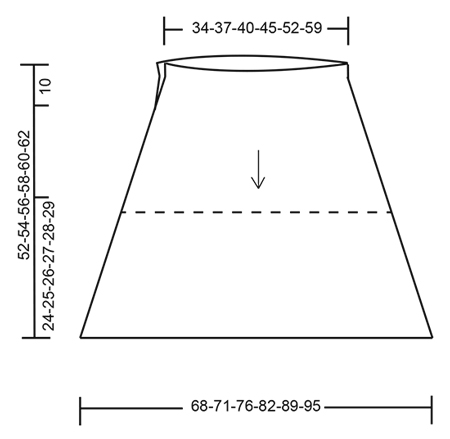
|
|||||||||||||||||||||||||||||||
Have you finished this pattern?Tag your pictures with #dropspattern #daniellacardigan or submit them to the #dropsfan gallery. Do you need help with this pattern?You'll find 12 tutorial videos, a Comments/Questions area and more by visiting the pattern on garnstudio.com. © 1982-2025 DROPS Design A/S. We reserve all rights. This document, including all its sub-sections, has copyrights. Read more about what you can do with our patterns at the bottom of each pattern on our site. |
|||||||||||||||||||||||||||||||









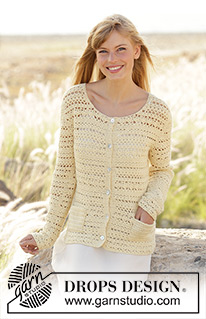
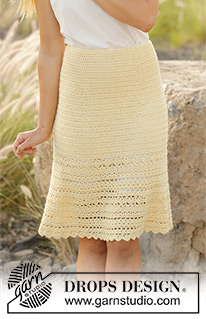

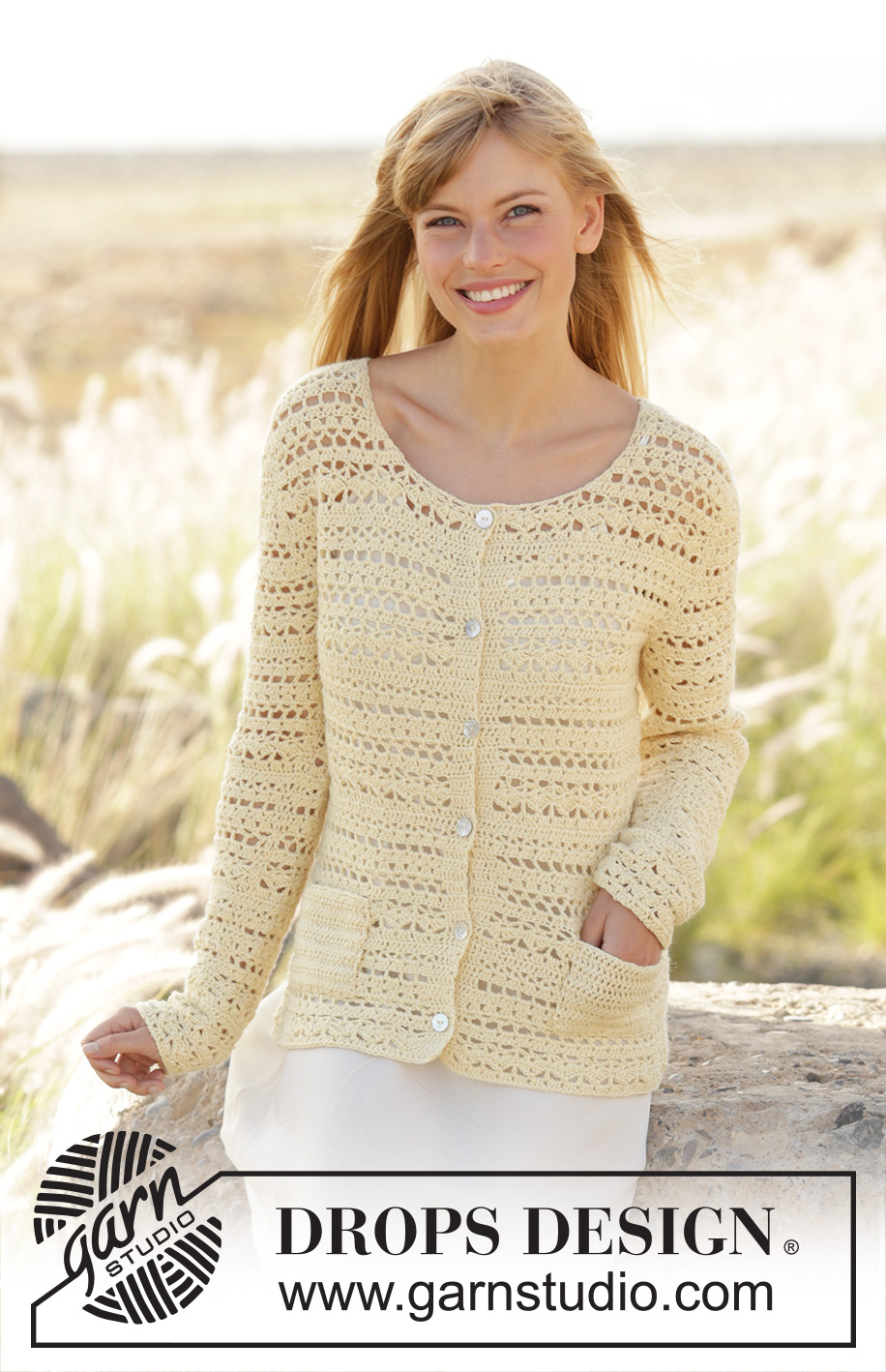
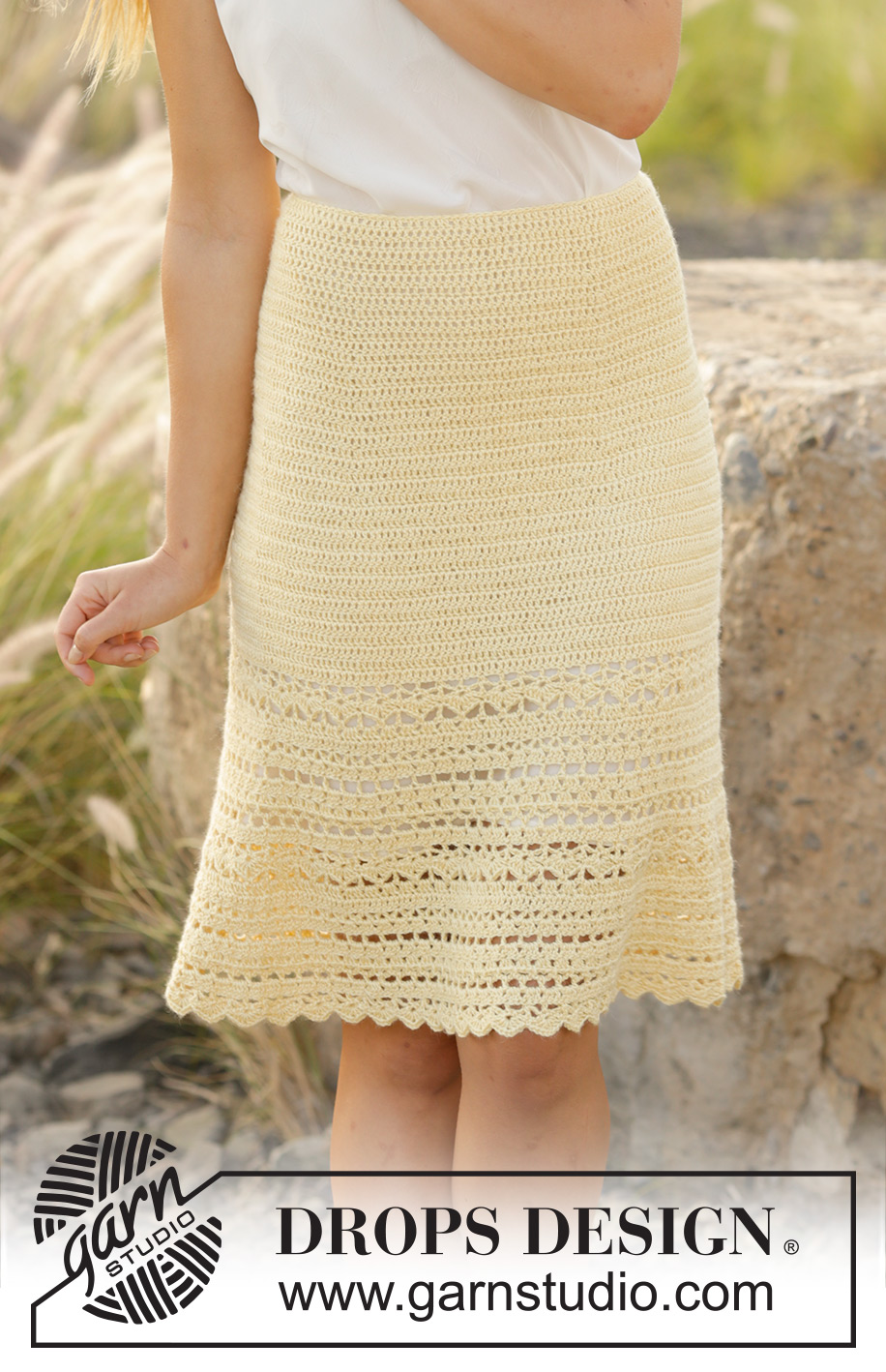







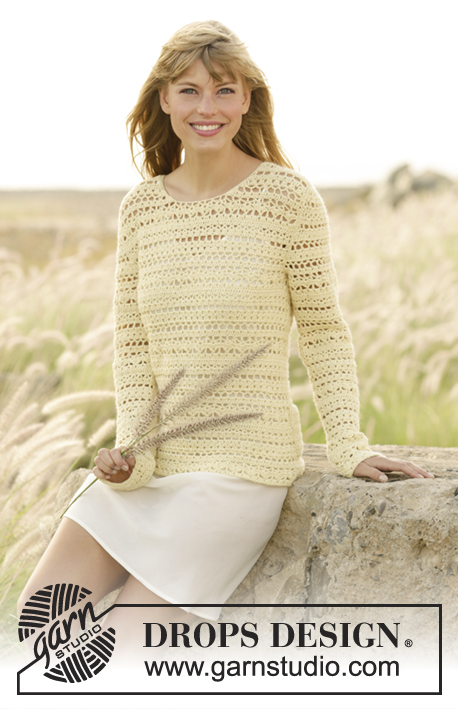
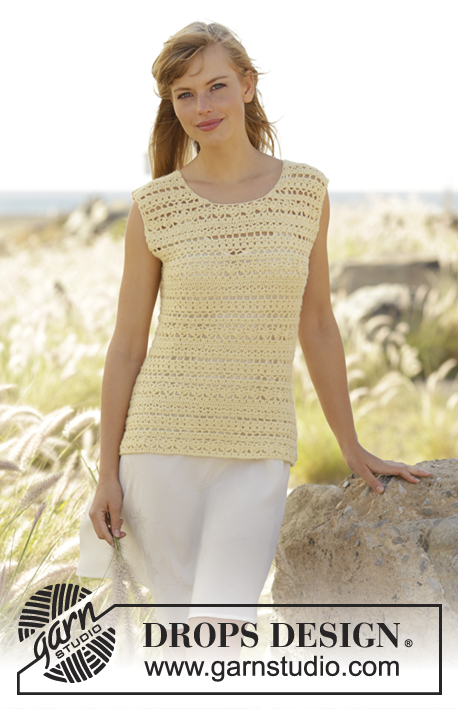



































Post a comment to pattern DROPS 170-31
We would love to hear what you have to say about this pattern!
If you want to leave a question, please make sure you select the correct category in the form below, to speed up the answering process. Required fields are marked *.